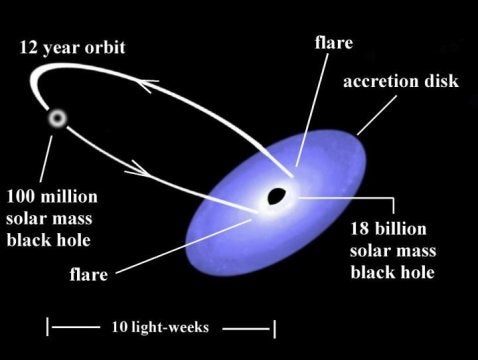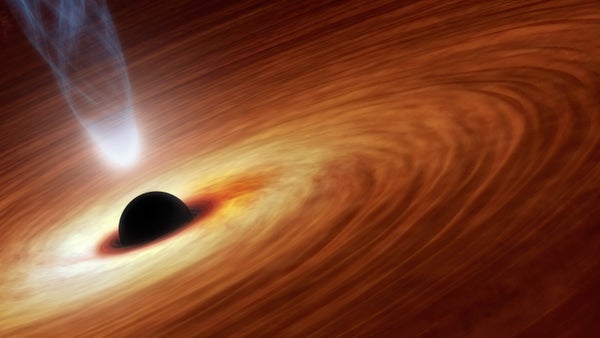This article was published in Scientific American’s former blog network and reflects the views of the author, not necessarily those of Scientific American
Black holes may be massive but they're also extraordinarily compact, and that makes them very challenging objects to evaluate across vast cosmic distances. The era of gravitational wave astronomy now opens up a new set of tools for probing these objects, but researchers actually have a multitude of other tricks up their sleeves for trying to pin down black hole properties.
A recently published work by Valtonen et al. in The Astrophysical Journal offers a glimpse into a particularly neat, and entirely natural black hole experiment that is also helping to reveal their physics.
The highly luminous system known as OJ 287 (a so-called BL Lac quasar) has been spotted by astronomical observations for the past 120 years - although its true nature wasn't recognized until the 20th century. At a distance of some 3.5 billion light years, OJ 287 is a remarkable binary supermassive black hole system sitting at a galaxy's core; two giant holes in bound in mutual orbit. The primary black hole weighs in at around 18 billion solar masses, the secondary at a mere 150 million solar masses.
On supporting science journalism
If you're enjoying this article, consider supporting our award-winning journalism by subscribing. By purchasing a subscription you are helping to ensure the future of impactful stories about the discoveries and ideas shaping our world today.
The visible light coming from this system (mainly produced by superheated material swirling about the larger black hole) varies quite regularly within a period of about 12 years. At its peak there are double spikes of brightness increases - thought to be due to the orbit of the smaller hole punching through the disk of matter that accretes around the larger hole. The general configuration is shown here:

Credit: Gary Poyner, UK
The timing of these outbursts not only allows the astronomers to estimate the masses of the black holes, but to see the precession - or shifting - of the elliptical orbit of the smaller hole. Orbital precession is a property of many astrophysical systems. Precession happens to the Earth's mildly elliptical orbit, but at a rate of about one complete orbital shift of 360 degrees per 112,000 years. By comparison, the OJ 287 system is on precession steroids, with the ellipse of the smaller hole's orbit rotating by 39 degrees each 12 year orbit - a direct consequence of the extreme warping of spacetime by the black holes.
The predictability of the orbital timing also allowed Valtonen and colleagues to prepare for an outburst as the smaller black hole punched through the larger accretion disk in November and December 2015 - nicely synchronized with the centennial anniversary of Einstein's theory of General Relativity.
By measuring precisely the variation in radiation from the system the astronomers were able to indirectly measure the actual spin of the primary, 18 billion solar mass black hole. The answer? It's spinning at 31% of the maximum allowed spin for a black hole (beyond which the singularity would, in principle, be exposed).
These data, together with the historical observations, also clearly indicate that the system must be losing energy via gravitational waves. In other words, in OJ 287 we really are witnessing the gradual inspiral of two supermassive black holes.
Intriguingly, this system also allows for constraints to be made on the 'no-hair' theorem for black holes, which is the idea that mass, spin, and electrical charge fully describe any hole, with no other characteristics needed - or allowed. One way to test this is to use the OJ 287 pair to place limits on the quadrupole moment of the larger black hole. The next opportunity to try this is coming in 2019, albeit at a challenging time as the Sun will appear close by, complicating the telescopic monitoring.
Black holes may be the most surreal and mind-bending objects in the universe, but we are beginning to get to know them awfully well.
